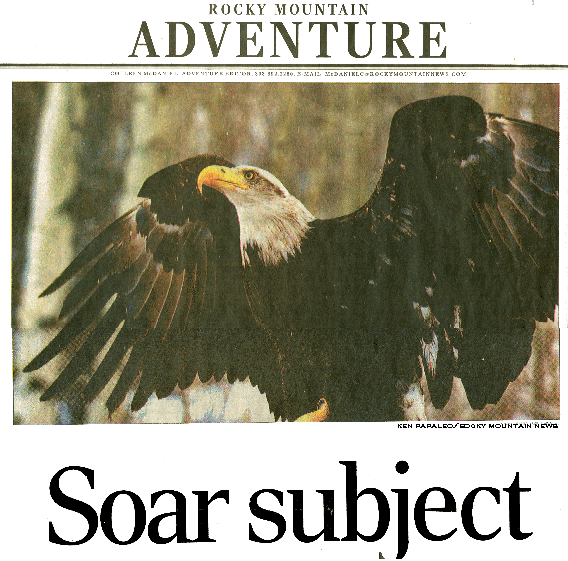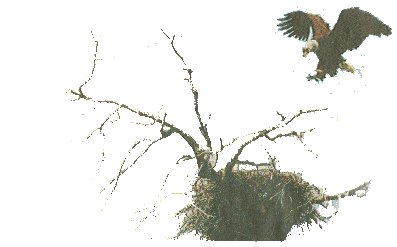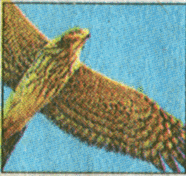|

|
|||
|
This bald eagle was displayed by HawkQuest at
a World Cup downhill ski race at the Birds of Prey course at
Beaver Creek in December 2003. Many bald eagles live in the
wild in Colorado. Careful attention has helped bald eagles,
endangered in the state only a few decades ago, achieve a population
of 700 to 900 in Colorado.
Careful attention has helped
develop a stable eagle population in Colorado
|
|||
|
By Gary Gerhardt |
The annual midwinter count shows a stable population of 700 - 900 eagles, according to the state Division of Wildlife. The other urban Denver nesting site is Standley Lake in Westminster, located a half-mile from suburban homes and considered one of the bald eagle nesting sites closest to an urban center in the United States. With bald eagles nursed back to healthy populations during the past 30 years, there are now more than 15 nests on the Front Range of Colorado and 30 more spread out on the Western Slope. "When I first started, we had one pair for sure by Electra Lake north of Durango, and another on the Little Snake River," Craig said. "Over the years, the numbers kept growing - sometimes with a little assist from us - and today there are at least 45." It took more than a "little assist" in many cases. Craig found nests destroyed after wind had whipped them out of cottonwoods or blown over entire trees. Such damage required putting a "basket" in the tree so the nesting pair could start over. That happened a number of times at Barr Lake. Craig once climbed a rotting cottonwood to install a superstructure for the eagles to use in building another nest, and then crossed his fingers that the birds would buy into the plan.  |
||
| Rocky Mountain News | |||
|
The 3-month-old bald eaglets huddled like two scared kids while a gaggle of photographers surrounded them at the Barr Lake gazebo. Division of Wildlife raptor expert Jerry Craig had snatched them out of their nest at the edge of the lake and boated to the gazebo so spectators could watch as he weighed the eaglet, drew blood from them and crimped bands on their legs. As the wildlife paparazzi snapped photos, the pair looked completely docile, swaying slightly on yellow feet that looked like clown shoes, with large talons digging into the wooden deck. But looks are deceiving. Place a hand on their chests and their tiny hearts tripped like jackhammers. Barr Lake is one of two Denver-area nesting sites that have produced young for more than a decade. Bald eagles prefer to nest in large trees near water. They feed mainly on fish, but in Colorado, because of the lack of water sources, they prey on waterfowl, rabbits, and rodents, particularly prairie dogs.
|
|||
|
|
|||
|
|
How to tell eagles from falcons and hawks Eagles are large and have large, broad winds. They soar, often at great height, and have slow deliberate wing beats. Falcons have long , slim wings that taper to pointed tips. In flight, the wings angle back at the wrists, and wing beats are rapid. Falcon bodies are sleek; they have round heads and long, narrow tails. Buteos, the soaring hawks, have blocky bodies, broad wings and short tails, Their characteristic hunting strategy involves soaring high over open country, then dropping to the ground to seize prey. Accipiters, the woodland hawks , have short, rounded wings and long tails. These adaptations allow them to maneuver quickly among trees while pursuing birds and small mammals. Their tails usually have light and dark bars. |
||
|
|
|||
 Accipiter Accipiter
|
|||
| Reprint from Rocky Mountain News January 3, 2004 | |||
Posted 1/2004

 Falcon
Falcon